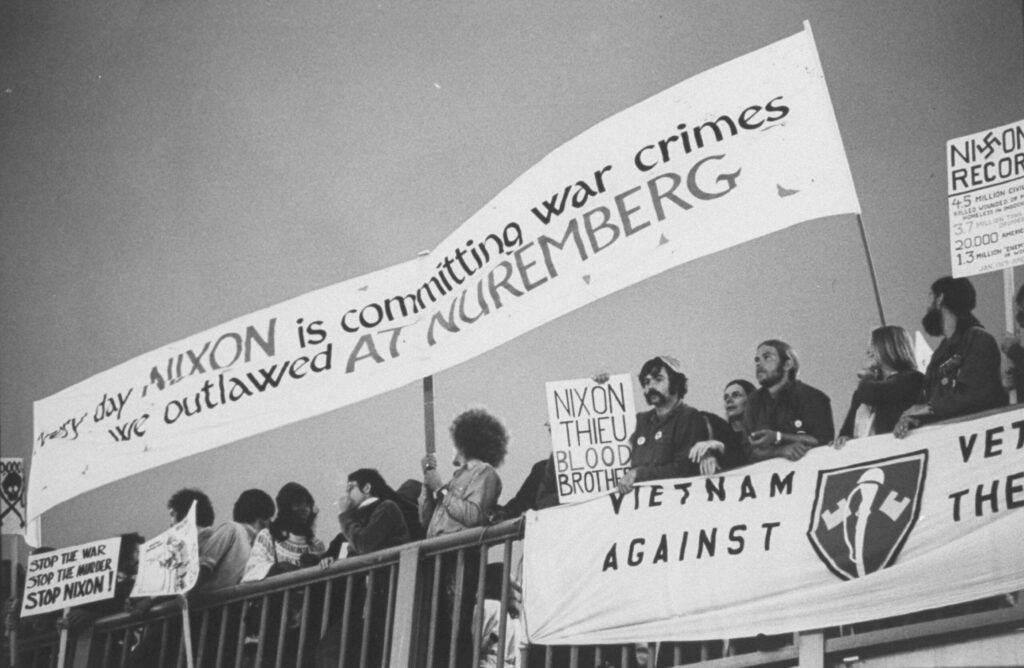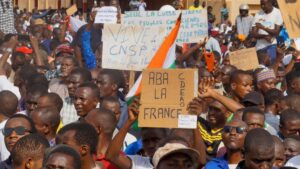January 27, 2023: Today marks the 50th anniversary of the Paris Peace Accords — signed on January 27, 1973 — that ended the U.S. war against Vietnam. Many in the U.S., such as American war veterans and refugees from southeast Asia, still live with the war’s traumatic legacies. But for others, it is an increasingly distant thing — something known less through living memory and more through Hollywood mythology and somber monuments.
This is less so in Vietnam, where most of the war occurred, and where its legacy remains soaked in the nation’s very soil and is seen in the bodies of even the young. Bomb craters still litter the land. The remains of hundreds of thousands of soldiers are still missing. Nearly endless amounts of unexploded ordnance remain in the ground: More than 100,000 people have been injured or killed by them since 1975. These bombs still explode today, maiming and killing those born well after the war ended.
There is also the dioxin contamination caused by years of the U.S. spraying Vietnam’s fields with millions of gallons of toxic chemicals like Agent Orange, a highly toxic defoliant. The Red Cross estimates that 3 million Vietnamese people have been affected by Agent Orange. This includes at least 150,000 children born after the war with conditions such as severe spinal deformity. The toxic legacy of Agent Orange also stretches into neighboring Laos and Cambodia.
Today, there are ongoing efforts in Vietnam to remediate these legacies of the U.S. war. For example, Bien Hoa, just outside of Vietnam’s largest city, Ho Chi Minh City, was the site of the busiest U.S. airbase during the war. Huge amounts of Agent Orange were stored there and saturated the area. It remains one of the most contaminated places in Vietnam, and the site of an ongoing cleanup effort.
“I Always Wondered Why Something So Unjust Happened to Us”
Growing up in Vietnam, Nguyet Nguyen, who teaches the history of the war at the University of Alaska Southeast, remembers seeing bomb craters and veterans with missing arms and legs. She remembers overhearing conversations about massacres.
It was just the air she breathed. “I saw everything around me, but I never questioned it,” she told Truthout. “It was just there.”
Nguyen came to the U.S. in 2007 as a Fulbright scholar to study communications. But her curiosity and “a certain sense of justice” kicked in, pulling her toward the history of the war.
“I always wondered why something so unjust happened to us,” she said.
Being in the U.S. made this urge even more pronounced, she said, when she encountered Americans who lamented that the U.S. “lost” the war. “It actually didn’t compute,” she said. “Does that mean that all this destruction, killing and suffering would have been okay if you had won?”
As a masters student, she wrote her thesis on the portrayal of the Vietnamese in U.S. war films like Apocalypse Now, where they are depicted as nameless and faceless, mere background actors to an American story. Even today, says Nguyen, many in the U.S. still “talk about the war as though the Vietnamese don’t exist.”
There’s “this undertone of putting the U.S. at the center of everything,” she said, as if the war mainly happened to Americans, and not the Vietnamese.
Toward War
The history of Vietnamese resistance to foreign domination goes back centuries, but most historians locate the origins of the U.S. war during World War II. The Viet Minh, with U.S. support, helped defeat the Japanese occupiers, and on September 2, 1945, Ho Chi Minh declared the founding of the independent Democratic Republic of Vietnam (DRV), invoking the U.S. Declaration of Independence in his speech.
The French, who had colonized Vietnam in the 19th century, had other ideas. Beginning in 1946, they waged a war to reconquer Vietnam. Against the DRV’s pleas, the U.S. sided with the French. Vietnamese forces fought France for the next eight years until they won a decisive victory at the Battle of Dien Bien Phu in 1954. The ensuing peace negotiations divided Vietnam in the middle, with the DRV controlling the north. An election within two years was supposed to reunify the nation.
That election never happened because Western powers knew Ho Chi Minh would win in a landslide. Instead, two sides hardened: a communist “North Vietnam” and an anti-communist “South Vietnam,” increasingly backed by the U.S. The fate of “South Vietnam” would largely drive the war over the next two decades. For many Vietnamese, South Vietnam was a fiction imposed by imperial powers. For the U.S., it was the anti-communist nation they would build to “contain communism.”
Into the early 1960s, conflict within South Vietnam escalated. The U.S. steadily backed an unpopular and brutal ruler, Ngo Dinh Diem. Resistance to the Diem regime grew in the countryside, turning into a full-fledged guerilla struggle waged by the newly formed National Liberation Front (NLF), aided by North Vietnam.
Amid growing unrest in South Vietnam, Diem was overthrown and killed in 1963. The U.S. backed a series of new leaders and the south’s military, the Army of the Republic of Vietnam (ARVN). But an anti-communist “South Vietnam” was an impossible project for the U.S. No ruler the U.S. backed had popular legitimacy. ARVN troops were corrupt and oppressive. The NLF was fighting for Vietnam’s independence. Escalating U.S. presence only emboldened nationalist resistance.
By 1965, with the situation for U.S.-backed forces in South Vietnam deteriorating, President Lyndon Johnson, deceitfully using the Gulf of Tonkin incident as a pretext, began sending hundreds of thousands of U.S. troops to Vietnam and started a three-year bombing campaign, turning the conflict into a full-fledged American war. By 1968, well over a half-million U.S. troops were in Vietnam.
“A Lot of Them Were Forgotten”
The war was unspeakably brutal. U.S. troops engaged in “search-and-destroy” missions in rural villages and were urged to maximize the enemy “body count.” But the “enemy” was a guerrilla movement with popular support across the countryside, and there was little distinguishing between soldier and civilian. “Kill anything that moves,” U.S. soldiers were told.
As journalist Deborah Nelson has shown, atrocities like the infamous My Lai massacre, where hundreds of villagers were murdered by U.S. troops in March 1968, only scratched the surface of U.S. brutality during the war. There were hundreds of alleged atrocities against the Vietnamese that were secretly documented by the U.S. army. As many as 2 million civilians perished, as did over a million Vietnamese troops fighting against the U.S. and ARVN.
Nguyen wishes there was more acknowledgement about the direct impact of the war on Vietnamese women who bore much of its brunt. “They were bombed, they were killed, they were raped,” she said, and much of this has been “subsumed into this generic, collective suffering.” In many cases, women became the main caretakers at home when men went off to fight and die or returned maimed.
“A lot of them were forgotten,” she said. “We need to acknowledge the sheer volume of trauma and suffering that they have experienced.”
At the same time, Nguyen stressed, Vietnamese women during the war were far from helpless victims. “They were fighting,” she said. “Women played a really significant role in the war, both in the north and the south,” including the “hundreds of thousands of women who were logistical staff workers” and who worked on the Ho Chi Minh trail.
Historians have documented the crucial combat and noncombat roles that Vietnamese women played in the wars for independence against the Japanese, French and U.S. from the 1940s through the 1970s. They laid traps, provided intelligence, bolstered supply lines, produced goods and shot weapons. They filled craters, hid fighters, suffered malaria and tended to the wounded under heavy fire. Many endured long and painful separations from their families in the fight for independence.
“They were working in a factory — but they were also carrying a rifle while they were making fabrics,” Nguyen said.
Nguyen also said that women in Vietnam who went through the war need more support today. Many who sacrificed for the war effort are not treated as official “veterans” and therefore don’t receive benefits, she says. Moreover, while the war was fought collectively, from the front lines to the factories to the farms, many women who responded to their country’s call have been left to deal with the aftermath individually.
Vietnamese women have “sacrificed silently since the war’s end,” said Nguyen, and they should be given more resources — from phones and laptops, to money for travel costs, to local and national organizations — to connect with each other. They should also be celebrated more in the collective commemoration of the war, but not as tokens.
“Their sacrifice was no less than that of men,” she says.
A Kind of Peace
In January 1968, the NLF and North Vietnamese troops staged the Tet Offensive, a stunning military offensive across dozens of cities, towns and villages in South Vietnam. While ultimately repelled, it was a tremendous political victory, showing the world — and particularly the U.S. public — that communist forces had broad support and would continue to fight.
Richard Nixon assumed office in 1969 and escalated the war by bombing Cambodia and Laos, increasing the air war, and ramping up support to the ARVN as part of his “Vietnamization” strategy. The U.S. antiwar movement that arose in the mid-1960s and swelled toward the decade’s end continued into the 1970s. The astounding deceit of the U.S. government was proven by the publication of the Pentagon Papers in 1971.
By 1972, the U.S. and North Vietnam seemed to have reached a peace deal. After a 60-day ceasefire, the U.S. would withdraw all its troops from South Vietnam. Crucially, North Vietnamese troops could stay in the south. The north conceded to a joint southern government with the U.S.-backed Nguyen Van Thieu in the south. American prisoners of war (POWs) would be returned to the U.S.
But Nixon backed out — and proceeded to wage one of the most merciless bombing campaigns of the entire war. The “Christmas Bombings” of December 1972 dropped an astounding 36,000 tons of bombs over North Vietnam, more than had been dropped in the entire period between 1969 and 1971. Nixon wanted to reassure Thieu that the U.S. would not abandon South Vietnam.
Finally, on January 27, 1973, all parties signed the “Agreement on Ending the War and Restoring Peace in Vietnam” — essentially the same deal agreed upon before the Christmas Bombings. Two years later, with the U.S. gone, Vietnam was reunified under communist rule.
Decades later, in 1995, Robert McNamara, the former U.S. defense secretary who oversaw the war’s escalation, told famed communist General Vo Nguyen Giap that the U.S. and Hanoi had perhaps “misunderstood each other” at times where the war could have been deescalated.
“Excuse me, but we correctly understood you,” interrupted Giap. “The war against you was a noble sacrifice. We did not want to fight the U.S…. But you gave us no choice.”
War Myths
Nguyen says it’s important today in the U.S. to continue to debunk the pervasive mythology that surrounds the war. On this topic, few people have as much to say as Jerry Lembcke, who has written numerous books dismantling these myths.
Lembcke was drafted into the army in 1968 and went to Vietnam as a chaplain’s assistant with the 41st Artillery Group. While enlisted, he learned about the antiwar movement and the long history of Vietnamese resistance to imperialism, he told Truthout.
Decades later, as a professor, Lembcke grew curious about commonly accepted “memories” about the war — for example, that U.S. soldiers returning from Vietnam were widely spit upon by antiwar protesters. He sensed that these were urban legends that were less about the history of the war and more about creating political consent for U.S. militarism.
He began to write books about these myths nearly three decades ago — and he’s never stopped.
Lembcke’s most well-known book, The Spitting Image, debunks the notion, often depicted in popular culture, that U.S. soldiers were spat upon. “There’s no evidence that it happened,” he told Truthout. Instead, the myth only gained salience in the 1990s, when conservative politicians and war hawks invoked it to build consent for U.S. imperial ventures in Iraq and elsewhere.
If anything, antiwar civilians worked with GIs to help build a movement of antiwar protest that went deep into the U.S. military — a “strong GI movement against the war in Vietnam,” as Lembcke said.
Hundreds of thousands of U.S. veterans, like millions of Vietnamese, were also exposed to Agent Orange by the U.S. government, and some have suffered severe health consequences ever since.
Lembcke says another area of mythology centers around former U.S. POWs in Vietnam, who have been depicted as zealously pro-war and wantonly tortured by the Vietnamese. Lembcke says both of these depictions are false.
“Thirty to 50 percent of POWs were opposed to the war before they were released,” he said. He elaborates on these and other points in his recent book, Dissenting POWs, coauthored with Tom Wilber, whose father was a POW who turned against the war.
On the question of widespread torture, Lembcke referenced memoirs by U.S. POWs who said they were not tortured. He said he has yet to read a POW’s memoir that mentions witnessing another POW being tortured.
“The truth is that we don’t know,” he said.
Lembcke says a range of “stabbed-in-the-back” myths around the Vietnam War — which posit that antiwar protesters and liberals betrayed U.S. soldiers and prevented victory — still pervade U.S. political culture. He said we really can’t understand the Trump movement to “Make America Great Again” without understanding this mythology.
To them, he said, “America lost its ‘greatness’ when it lost the war in Vietnam.”
“Don’t Stop” Fighting for Peace and Justice
Nguyen, who researches the transnational movement against the war, centering the role of the Vietnamese, said it’s important today to remember the profound impact of the antiwar movement, especially in restraining the war’s brutality. She brings up several instances where the peace movement in the U.S. helped prevent further escalation, including when the U.S. contemplated using nuclear weapons.
While Nguyen doesn’t think the antiwar movement decisively impacted the war’s outcome, she believes it had a major impact. Given all the killing and destruction that did happen, she wonders what kind of destruction could have happened without a peace movement.
“Imagine what would have been,” she said. “Those movements really made a difference in alleviating the suffering of the people in those conflicts” and may have “helped shorten the conflict.”
When reflecting today on the legacy of peace efforts and other movements for justice during the war, Nguyen has some clear advice.
“They work. So don’t stop.”
(Derek Seidman is a writer, researcher and historian living in Buffalo, New York. Courtesy: Truthout, a US nonprofit news organization dedicated to providing independent reporting and commentary on a diverse range of social justice issues.)




